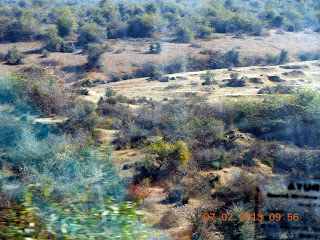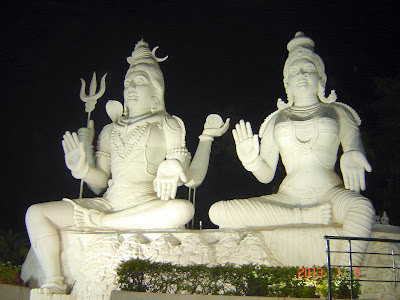(This is third of the five blog series covering our Bhopal trip)
 I also noticed that on stones fixed on the wall of the temple, there are different markings which were perhaps made by different artisans. Why did they do that? Obviously, to clearly demarcate the job done by each person? Was the system of performance linked wages prevalent then?
I also noticed that on stones fixed on the wall of the temple, there are different markings which were perhaps made by different artisans. Why did they do that? Obviously, to clearly demarcate the job done by each person? Was the system of performance linked wages prevalent then?
We saw everything with a lot of inquisitiveness, walked over sandstone rocks and reached Betwa, (known as River Vetravati in ancient times), looked at the unique dam created on the bridge, which was said to be destroyed by Hoshang Shah of Malwa in the 15th century when one of his soldiers died while crossing this river. Another legend says that he got it destroyed because bandits used to hide here and attack the caravans of local merchants passing through this area.
 The place was quiet and serene and made us feel very much at peace with ourselves. But it was time to go back and we left this place much against our wishes cherishing the peaceful surroundings, mesmerising building and a mind full of thoughts and ideas of what must have happened in this place some 1000 years ago, everything shrouded in mystery.
The place was quiet and serene and made us feel very much at peace with ourselves. But it was time to go back and we left this place much against our wishes cherishing the peaceful surroundings, mesmerising building and a mind full of thoughts and ideas of what must have happened in this place some 1000 years ago, everything shrouded in mystery.
 |
| Shiva Temple, Bhojpur (MP), India |
On a short visit to Bhopal, the capital of Madhya Pradesh, I suggested that we visit Bhojpur Shiva Temple. Though I had been there earlier for a short trip but wanted Shiv, my husband to see this unique engineering marvel located on the banks of river Betwa in District Raisen at a distance of about 30 km from Bhopal.
His negative reaction was spontaneous, “No mandir-shandir! They are all the same… ritualistic, dirty and filthy…. money making factories. Let’s not waste time.”
 |
| Shiva Linga in the sanctum sanctorum of Bhojpur Shiv Temple is 21' high and is made of one solid single rock |
“Look, this is not a usual pooja-wala temple. It is different. It’s carved out of solid sandstone rocks available locally around that area and is an engineering marvel. Imagine, it has the biggest Shiva Linga in the country which is about 21 feet tall and made of a single rock. And do you know that it was built about 1000 years ago and is still incomplete?” I rattled off in a single breath.
“It is known by many names, Bhoj Temple, Bhojeshwar Temple or Bhojaswamin Temple because Shiva was perhaps the main deity of Raja Bhoj.”
“Is this the same Raja Bhoj about whom we…..?”
Reading his mind instantaneously, I interrupted, “Yes, yes the same…... Aadhe mein Raja Bhoj aur aadhe mein Gangoo Teli ka poora pariwar.” We both burst out laughing and decision-making became easier. So here we go!
 |
| The entrance is decorated with statues of Kuber, Ganga and Yamuna |
We drove down to this “wow” place built during the time of Raja Bhoj of Parmar dynasty who ruled central India from 1000 to 1055 AD. Reaching there, the first thing that I noticed about the temple, even from a distance, was that its structure was unique. It did not look like any of our usual Hindu Temples dotting across the length and breadth of the country. I thought it looked more like those Greek structures. Am I imagining things?
Reaching closer, I saw that it was under the protection of Archaeological Survey of India. A board displayed there stated that this structure was never completed. Why is it lying unfinished even after 1000 years, we wondered. Raja Bhoj ruled this area for over 50 years and was known to be a great patron of art and culture. Why then could he not get it completed? Was it lack of resources or loss of expertise?
There are a number of folklores about the incomplete status of the temple. According to one such folklore that did not sound too convincing, the temple was to be built in one night. As the night got over, the plan had to be abandoned. Makes no sense whatsoever!
 |
| These local rocks have been used in the temple |
Another legend says that the King suffered from some skin ailment, leprosy to be precise, and started concentrating on getting lakes and dams made where water from different sources could be collected for his treatment. Yet another one says that Mohammed Ghori had attacked Somnath Temple and all the resources were diverted in that direction. Another story says that the King became unwell and the project had to be given up. Also, perhaps the King had to move towards Malwa to tackle some threats there. They compelled me to think, but I could not reach any conclusion. To my creative mind, it was the loss of expertise. Otherwise, nobody would leave a well-planned beautiful project like this midway.
 |
| All devotees do worship here only not inside the temple. |
The temple is on a little higher rocky area and is built on three levels.
Big wide steps, again more Greek than Indian in design, lead to a higher level where there is a place of worship outside the temple. The main temple is on the next plane.
 |
| All devotees do their worshipping rituals outside the main temple only. |
Usually, in all Hindu temples the sanctum sanctorum is quite small and the hall around is large. However, in this temple, the Shiva Linga takes almost three fourth of the space with hardly any area left for the devotees. May be it was only the garbha-griha (sanctum-sanctorum) and the main temple was still to be built around it. The access to the Lingam is also by way of steps which have since been closed.
Prima facie, this temple appeared to be an engineering marvel. Made of huge single piece sandstones, one wonders how these huge stones were lifted to that height without the facility of cranes those days. There is a slope at the backside of the temple that was perhaps used as a ramp for rolling the stones towards the construction site. But the stones are massive. How many men would it have taken to roll even one stone? Well, I am confused now.
The drawings for the structure have been etched on the stones on the floor and are visible even now. According to these, there was a big plan for a huge building. I wondered who had prepared these rock drawings? To my creative mind, was there a special team from some other country that might have left the project due to some reasons leaving the work mid-way?
 I also noticed that on stones fixed on the wall of the temple, there are different markings which were perhaps made by different artisans. Why did they do that? Obviously, to clearly demarcate the job done by each person? Was the system of performance linked wages prevalent then?
I also noticed that on stones fixed on the wall of the temple, there are different markings which were perhaps made by different artisans. Why did they do that? Obviously, to clearly demarcate the job done by each person? Was the system of performance linked wages prevalent then? |
| Incomplete statues & decoratives are all over the place. Why were they left like this abruptly? |
There are a number of half-carved statues and decorative designs lying all around the place half done as if somebody had to leave everything abruptly.
There is also a stone-grinding type of broken equipment lying there even today.
 |
| The dam on River Betwa destroyed by Hoshang Shah in the 15th Century |
We saw everything with a lot of inquisitiveness, walked over sandstone rocks and reached Betwa, (known as River Vetravati in ancient times), looked at the unique dam created on the bridge, which was said to be destroyed by Hoshang Shah of Malwa in the 15th century when one of his soldiers died while crossing this river. Another legend says that he got it destroyed because bandits used to hide here and attack the caravans of local merchants passing through this area.
 The place was quiet and serene and made us feel very much at peace with ourselves. But it was time to go back and we left this place much against our wishes cherishing the peaceful surroundings, mesmerising building and a mind full of thoughts and ideas of what must have happened in this place some 1000 years ago, everything shrouded in mystery.
The place was quiet and serene and made us feel very much at peace with ourselves. But it was time to go back and we left this place much against our wishes cherishing the peaceful surroundings, mesmerising building and a mind full of thoughts and ideas of what must have happened in this place some 1000 years ago, everything shrouded in mystery.












































